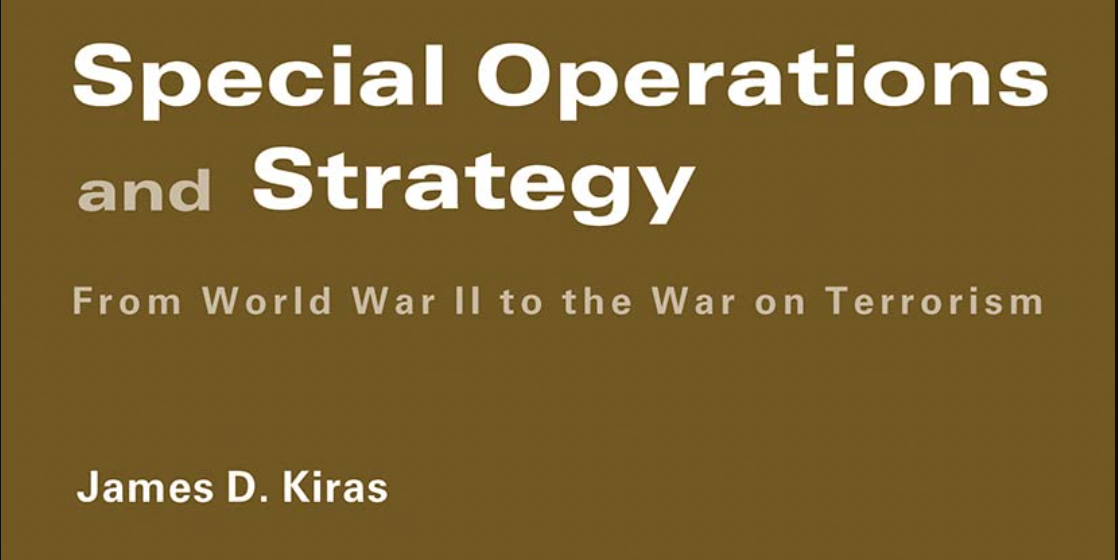Beyond Hollywood.
As promised by its title, the security scholar James Kiras’s 2006 book effectively explores the interrelated topics of Special Operations and Strategy. Kiras offers a critical view of some of the most highly praised special operations and skillfully shows his readers how a more nuanced perspective may better our understanding of the strategic capabilities of special operations.[1] Today Kiras teaches at the US Air Force School of Advanced Air & Space Studies and is a recognized specialist in irregular warfare and special operations. Kiras argues that apart from the moral and tactical profits from spectacular special operations often depicted in movies and books, the strategic value of special operations is found in how they are employed in attrition warfare and how they enhance the effects of other forces.[2]
This scholarly book is based on the author’s doctoral thesis and takes a focused view of historical operations and strategic theory.[3]Kiras should not be read for colorful tales of daring bravado. Rather the inclusion of special operations from the past serves to frame and explain his core theory. The focal point of the book is Clausewitzian theory regarding the forms of war: the use of force to impose one’s will, and the unpredictability of battle caused by the fog of war. By incorporating later theorists like J.F.C. Fuller, John Warden, and John Boyd, Kiras studies how the idea of the “Great Raid” grew with the desire to quickly end conflicts.[4] Kiras asks, “can special operations plan to conduct such spectacular operations and achieve strategic significance with one blow?” Countering the claims of some advocates, Kiras argues that little proof is found that “strategic paralysis” works, because the ability to predetermine the outcome of a spectacular decapitation operation, is impossible to accurately predict in a complex and changing environment.[5] He exemplifies this by looking at the actual outcome of the famous Dambusters raid of May 1943: a daring mission that planners expected to break the back of the German industry and with it civilian morale.[6]. The raid was a tactical success, but the anticipated domino effect never happened.

Instead of “great raids” Kiras argues for “attrition warfare” which to his mind has been misunderstood as purely defensive, expensive, and reactive.[7] Attrition warfare can function as both offense and defense and, if applied correctly, provides decision-makers with a choice between maneuver and battle, whereas the annihilation strategy forces a path of battle.[8]
While the book strongly emphasizes that conventional forces are the foundation upon which attrition warfare must be waged, Kiras contends that special operations are a factor that can tip the balance.[9] Special operations can degrade morale and hit targets of strategic significance that will tip the scales in favor of their own side. Mao and T.E. Lawrence are exemplified as two role models who understood how to use partisan or guerilla forces in a war of attrition, to strike at the right time, with the right means, and at the right targets to achieve strategic victory.[10]
One aspect omitted by the book is the use of special operations in low-intensity conflict and how they may serve as a tool of deterrence or compellence. The close connection between attrition warfare and low-intensity conflict would make for a very interesting angle to exploit to get a strategic perspective on special operations, after the very strong arguments presented in favor of attrition. Kiras largely has a perspective on strategy as employed by coalitions (allies in WWII in chapters 3 and 5) and less on how individual states or organizations may achieve strategic goals via special operations, partisan movements, or irregular warfare.[11] These are some of the nuances not fully exploited by Kiras that may apply to other circumstances and serve as topics for future researchers.
On the whole Special Operations and Strategy challenges its reader to ask: “special operations may be doing things right, but are they doing the right things?” It brings new perspectives to a continually developing branch of the armed forces as well as strategy in general. The skeptic who disregards special operations as overrated may find attractive applications of special operations in this book that better supports conventional forces. Supporters of special operations may broaden their perspective to use them more effectively to go beyond tactical success and strive for strategic impact. In this, it is worthwhile both for the skeptic and the advocate.
[1] Kiras deals with the Dambuster raid in 1943 in detail, but also touches on “The Telemark Raid” of February 1943, the attack on the fortress of Eben Emael in May 1940, the ideas of Otto Skorzeny relating to neutralizing enemy leadership, SAS operations in Northern Ireland and US operations in Somalia in 1993 amongst others. The author also includes further inspiration on great raids in his notes for interested readers. James D. Kiras, Special Operations and Strategy: From World War II to the War on Terrorism, Cass Series--Strategy and History 17 (London ; New York: Routledge, 2006), 1–2, 9, 17, 76, 79, 118–19.
[2] Kiras, 58, 79.
[3] James Drew Kiras, “Rendering the Mortal Blow Easier: Special Operations and the Nature of Strategy” (Ph.D., University of Reading, 2004), https://ethos.bl.uk/OrderDetails.do?uin=uk.bl.ethos.402068.
[4] Kiras, Special Operations and Strategy: From World War II to the War on Terrorism, 16–34.
[5] Kiras, 33–34.
[6] Kiras, 36–54.
[7] Kiras, 59.
[8] The theorist Hans Delbrück argued for the definition of strategy into two forms: attrition and annihilation. Kiras, 65–66.
[9] Chapter 4 ends with a counterfactual pondering by Kiras on how the SAS could more effectively have supported the allied campaign in France after the landings in Normandy 1944, as an example of how special operations can support a war of attrition. Kiras, 105–11.
[10] T. E. Lawrence used Arab tribes to harass Turkish supply lines without directly confronting the Turkish until they withdrew from the contested area. Mao likewise weakened the Nationalist Chinese though protracted guerilla warfare to a stalemate and finally gained control of mainland China through a strategic offensive. Kiras, 69–73.
[11] Mainly the Allies in WWII Kiras, 16–34, 83–111.







